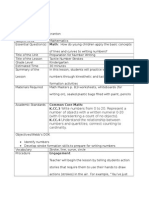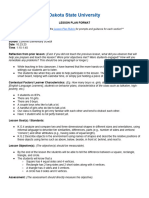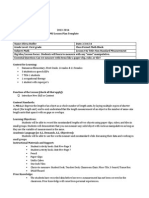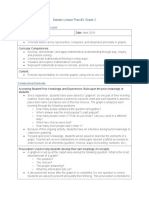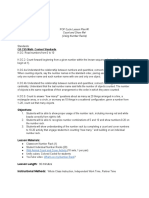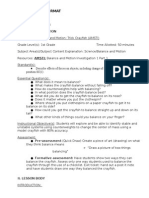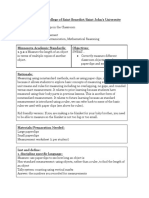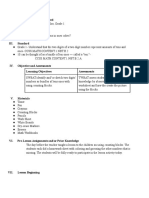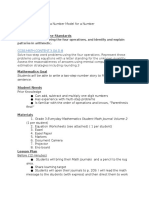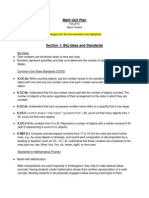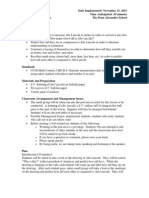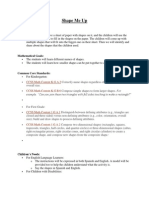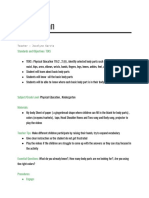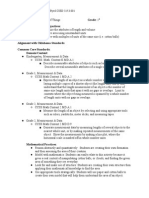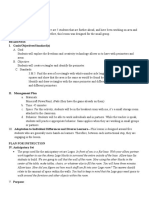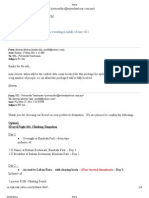Mathunit 1
Mathunit 1
Uploaded by
api-208843281Copyright:
Available Formats
Mathunit 1
Mathunit 1
Uploaded by
api-208843281Original Title
Copyright
Available Formats
Share this document
Did you find this document useful?
Is this content inappropriate?
Copyright:
Available Formats
Mathunit 1
Mathunit 1
Uploaded by
api-208843281Copyright:
Available Formats
Measurement and Data Center By: Kelly Hahn & Sammie DeLeon Content and Task Decisions Grade
e level: K and 1st Unit: Measurement and Data Overview We will be having the children pair up and measure each other with the unifix cubes. Each child will have a chance to measure their partner. Then, the students will write down the number of unifix cubes it took to measure their partner on a post-it note. After, we will start/continue creating a poster collecting all the different height measurements. Mathematical Goals/Objectives Students will identify measurable attributes of their body. Students will work cooperatives in pairs to measure heights using unifix groups. Students will compare heights indirectly by using their unifix cube measurements. Common Core Standards CCSS.Math.Content.1.MD.A.2 Express the length of an object as a whole number of length units, by laying multiple copies of a shorter object (the length unit) end to end; understand that the length measurement of an object is the number of same-size length units that span it with no gaps or overlaps. Limit to contexts where the object being measured is spanned by a whole number of length units with no gaps or overlaps. CCSS.Math.Content.K.MD.A.2 Directly compare two objects with a measurable attribute in common, to see which object has more of/less of the attribute, and describe the difference. For example, directly compare the heights of two children and describe one child as taller/shorter. Childrens Needs: For English Language Learners Reiterate directions in multiple ways to ensure comprehension. Visual demonstration: Teachers using unifix cubes to measure each other. Verbal directions Incorporate counting up unifix cubes in different languages such as English and Spanish. For Children with Disabilities Use hand-over-hand modeling to help students to stack unifix cubes -- helpful for students with fine motor problems. Thoughtfully partner up students in pairs that are supportive and foster learning. Materials Unifix cubes
Post-It Notes Pencils Dry erase board and marker Lesson Before Present the focus task: What are some ways to measure things? Do you think we could use these cubes to measure our friends? We are going to use these cubes to measure our friends and make a graph. Have you guys ever made a graph before? After we measure each other we will be able to discuss what we got when we measured our friends. We will also make a graph together--you guys will help us figure out where to place the numbers on graph. Who is the tallest? We are going to figure out how many of these unifix cubes it takes to measure you. Provide clear expectations: These are unifix cubes, and they will only be used to for measuring your partner. Do you think we should throw the unifix cubes? Should they go in our mouths? When you are finished measuring your partner, you can set your unifix measurements on the table so that we know you are done. We will let you know when it is time to switch partners. Demonstrate how to stack the unifix cubes. During Initially Make sure that each pair of students receives enough unifix cubes. As well, make sure that each student has a post it note/piece of paper and a writing utensil to write down their heights. If there is an odd number of students, a teacher will pair up with that odd numbered student. Ongoing Observe the students while they measure each other with unifix cubes. Some children may count while they are building, while others may build first and count the cubes after. Observe to see how the children are measuring each other--some children may lay down on the floor to be measured, and others may stand to be measured. After about three minutes, the students will be asked to switch. The measured partner will now measure the other partner. After all students have been measured, the group will reconvene.
After Bring the group together and make the graph. Ask the children what should be on the graph. What should go on the vertical and horizontal axis, etc. Compare data by using unifix cubes (concrete) and recorded numbers. Who is the tallest in the group? Can you show us how you knew that on the graph? Can someone else show us how you can tell using the unifix cubes, Assessment Observe Look at how students are measuring one another: Are they measuring as their partner is laying down or standing up? Are they counting as they stack each cube or counting the collective measurement afterwards? Watch to see if they students are completing the task as given: Are they using the unifix cubes appropriately? Are they following the given roles? Is one person being measured while another is using the unifix cubes to measure their partner? Are the students engaged in the activity? This can show confusion or interest level. Ask During How many cubes do you have so far? Are there enough cubes to measure your friend? Where should you start their measurement? (feet or head) How many total cubes do you have? Can you write that number? After (graphing) Who has the most cubes? What does having the most cubes mean? Who has the least amount of cubes? What does having the least amount of cubes mean? Where should we place this post-it note? Looking at the graph, who has the most/least? How can you tell?
You might also like
- Hall Ticket IgnouDocument1 pageHall Ticket IgnouPranjalGoelNo ratings yet
- Lesson Plan MeasurementDocument4 pagesLesson Plan MeasurementJohnGalindez50% (2)
- Sample Voc Rehab Strategic GuideDocument26 pagesSample Voc Rehab Strategic Guideb_l_krause100% (1)
- Lesson Plan AnglesDocument3 pagesLesson Plan Anglesapi-321289595100% (2)
- Physics GlossaryDocument21 pagesPhysics GlossaryKing VaibhavNo ratings yet
- 6e Sample Lesson PlanDocument6 pages6e Sample Lesson Planapi-26271422580% (5)
- Rounding Lesson Observation One 1Document3 pagesRounding Lesson Observation One 1api-448791207No ratings yet
- Memmert Et Al 2017 - Current Approaches To Tactical Performance Analyses in Soccer Using Position DataDocument10 pagesMemmert Et Al 2017 - Current Approaches To Tactical Performance Analyses in Soccer Using Position DataMasood GolshanyNo ratings yet
- Lesson Plan - Math ClotheslineDocument2 pagesLesson Plan - Math Clotheslineapi-490552326No ratings yet
- Kindergarten MathDocument4 pagesKindergarten Mathapi-314820450No ratings yet
- Pair Sets One To One Math Lesson PlanDocument5 pagesPair Sets One To One Math Lesson Planapi-563439476No ratings yet
- Math Lesson PlanDocument5 pagesMath Lesson Planapi-594519491No ratings yet
- Stoffer Early Childhood Plans For Learning SegmentDocument7 pagesStoffer Early Childhood Plans For Learning Segmentapi-253427643No ratings yet
- College of Education Lesson Plan On The SquareDocument7 pagesCollege of Education Lesson Plan On The Squareapi-498424232No ratings yet
- Sample Lesson Plan #3: Grade 2: Grade Level: Date: Big Idea(s)Document3 pagesSample Lesson Plan #3: Grade 2: Grade Level: Date: Big Idea(s)api-452943700No ratings yet
- Small Group Lesson Plan 1Document5 pagesSmall Group Lesson Plan 1api-594519491No ratings yet
- Lesson Plan: Curriculum ConnectionsDocument6 pagesLesson Plan: Curriculum Connectionsapi-311700306No ratings yet
- Math Art Lesson PlanDocument6 pagesMath Art Lesson Planapi-386069090No ratings yet
- POP Lesson #1Document3 pagesPOP Lesson #1Melissa Diaz-TrejoNo ratings yet
- Amstiscienceunitlessons 1Document13 pagesAmstiscienceunitlessons 1api-241792007No ratings yet
- Sioplessonplan AssessmentofellsDocument5 pagesSioplessonplan Assessmentofellsapi-2524947340% (1)
- Measuring With Non-Standard Units: Process Goals: Selecting Tools Communicating Mathematical IdeasDocument8 pagesMeasuring With Non-Standard Units: Process Goals: Selecting Tools Communicating Mathematical Ideasapi-117130448No ratings yet
- Lesson Plan College of Saint Benedict/Saint John's UniversityDocument6 pagesLesson Plan College of Saint Benedict/Saint John's Universityapi-338927224No ratings yet
- LessonstudylessonplanDocument3 pagesLessonstudylessonplanapi-250964578No ratings yet
- Math Methods Byer Lesson Plan 1Document6 pagesMath Methods Byer Lesson Plan 1api-594414040No ratings yet
- College of Education Lesson Plan Number 5Document8 pagesCollege of Education Lesson Plan Number 5api-498424232No ratings yet
- Edited Even & Odd Lesson PlanDocument6 pagesEdited Even & Odd Lesson PlanJennifer HesterNo ratings yet
- Math Lesson Plan 2nd GradeDocument5 pagesMath Lesson Plan 2nd Gradeapi-317499591No ratings yet
- Lesson 8-Ashley MoliseeDocument5 pagesLesson 8-Ashley Moliseeapi-631409397No ratings yet
- Unit 6Document4 pagesUnit 6api-245823147No ratings yet
- Individual Lesson Plan ReadinessDocument7 pagesIndividual Lesson Plan Readinessapi-386067949No ratings yet
- On Assignment Graph Paper.: Jelly Bean Cheat Code 111.7 (B) (6) (A)Document5 pagesOn Assignment Graph Paper.: Jelly Bean Cheat Code 111.7 (B) (6) (A)api-412946174No ratings yet
- 5E Lesson PlanDocument2 pages5E Lesson Planapi-486334632No ratings yet
- Sample Co-Teaching Lesson Plan (Direct Instruction) : Time: 3 MinutesDocument5 pagesSample Co-Teaching Lesson Plan (Direct Instruction) : Time: 3 Minutesapi-307753858No ratings yet
- Lesson Plan Odd or EvenDocument2 pagesLesson Plan Odd or Evenapi-564595992No ratings yet
- Lesson PlanDocument3 pagesLesson Planapi-355609484No ratings yet
- Alignment With Maine Standards: Ccss - Math.Content.3.Oa.D.8Document10 pagesAlignment With Maine Standards: Ccss - Math.Content.3.Oa.D.8api-357146792No ratings yet
- Lesson 3 - UnitDocument6 pagesLesson 3 - Unitapi-242431906No ratings yet
- UNLV/Department of Teaching & Learning Elementary Lesson PlanDocument11 pagesUNLV/Department of Teaching & Learning Elementary Lesson Planapi-349226396No ratings yet
- Theme Lesson Plan-GraphingDocument4 pagesTheme Lesson Plan-Graphingapi-253257946No ratings yet
- Daily LessonDocument4 pagesDaily Lessonapi-316644222No ratings yet
- How To Make A RulerDocument4 pagesHow To Make A RulerJaime FurstNo ratings yet
- Math Unit PlanDocument33 pagesMath Unit Planapi-252157943No ratings yet
- Term III Math OriginalDocument4 pagesTerm III Math Originalapi-242285135No ratings yet
- Observed Lesson 2 11 30Document5 pagesObserved Lesson 2 11 30api-700071491No ratings yet
- Have Students Put Home Link Page 71 Into Mailboxes. - 1:30 P.MDocument5 pagesHave Students Put Home Link Page 71 Into Mailboxes. - 1:30 P.MJulieNo ratings yet
- Fractions On A Number Line To 1 - Lesson PlanDocument4 pagesFractions On A Number Line To 1 - Lesson Planapi-376074224No ratings yet
- Math Lesson-ShapesDocument3 pagesMath Lesson-Shapesapi-206093485No ratings yet
- First Observation LessonDocument3 pagesFirst Observation Lessonapi-597953642No ratings yet
- 2nd Grade Math Measurement UnitDocument8 pages2nd Grade Math Measurement Unitcjcampbell08No ratings yet
- Creating Finding Perimeter Straw ActivityDocument3 pagesCreating Finding Perimeter Straw Activityapi-271760348100% (1)
- Developmental Lesson Plan: Common Core/PA Standard(s)Document10 pagesDevelopmental Lesson Plan: Common Core/PA Standard(s)api-434208019No ratings yet
- Maths Booklet Lesson Plan 8Document4 pagesMaths Booklet Lesson Plan 8api-477938936No ratings yet
- Lesson PlanDocument3 pagesLesson Planapi-533488969No ratings yet
- Chris Mohr - Classroom Management Key ComponentsDocument7 pagesChris Mohr - Classroom Management Key Componentsapi-566003527No ratings yet
- Title of Lesson: The Area of Things Grade: 1 Mathematics Learning ObjectivesDocument4 pagesTitle of Lesson: The Area of Things Grade: 1 Mathematics Learning Objectivesapi-282373455No ratings yet
- Place Value Lesson PlanDocument3 pagesPlace Value Lesson Planapi-306040952No ratings yet
- Abby Greenfield 2 Grade Lesson RationaleDocument3 pagesAbby Greenfield 2 Grade Lesson Rationaleapi-400235670No ratings yet
- UBD (Understanding by Design) Lesson Plan Framework and RubricDocument4 pagesUBD (Understanding by Design) Lesson Plan Framework and Rubricapi-385199730No ratings yet
- Levers 4Document8 pagesLevers 4api-434208019No ratings yet
- Wholegrouplessonplan-Mikalamuskelly 2Document8 pagesWholegrouplessonplan-Mikalamuskelly 2api-338990023No ratings yet
- K-8 Math Methods-Dsu Lesson PlanDocument4 pagesK-8 Math Methods-Dsu Lesson PlanShelly TownleyNo ratings yet
- Popcorn CylindersDocument4 pagesPopcorn Cylindersapi-309050107No ratings yet
- Environmental AssessmentDocument5 pagesEnvironmental Assessmentapi-208843281No ratings yet
- Lesson 1 Week 8Document4 pagesLesson 1 Week 8api-208843281No ratings yet
- Lesson 3 Week 11Document4 pagesLesson 3 Week 11api-208843281No ratings yet
- Lesson StudyDocument5 pagesLesson Studyapi-208843281No ratings yet
- Windows Windows WindowsDocument1 pageWindows Windows Windowsapi-208843281No ratings yet
- Truth in Lending Act SlidesDocument6 pagesTruth in Lending Act SlidesSherine Vizconde100% (1)
- SpreadsheetDocument11 pagesSpreadsheetShiva JK0% (1)
- Students Absenteeism and Its Implication to Academic Performance (2) (1)Document20 pagesStudents Absenteeism and Its Implication to Academic Performance (2) (1)jerwinera29No ratings yet
- Delhi Skill and Entrepreneurship University Government of NCT Delhi Application Form For The Post of Partnerships (External Relations Manager)Document3 pagesDelhi Skill and Entrepreneurship University Government of NCT Delhi Application Form For The Post of Partnerships (External Relations Manager)ibad razaNo ratings yet
- Douglas - Echo Sounding - 1929 PDFDocument10 pagesDouglas - Echo Sounding - 1929 PDFdj_salinger6212No ratings yet
- Didactics of English AssingnmentDocument9 pagesDidactics of English AssingnmentPuto NelsinhoNo ratings yet
- 30 Beautiful DuaDocument7 pages30 Beautiful DuaHassan NawazNo ratings yet
- LCP - Macatcatud PS School Year 2021-2022Document7 pagesLCP - Macatcatud PS School Year 2021-2022Geoff ReyNo ratings yet
- BOUQUETDocument23 pagesBOUQUETMhd TaufiqNo ratings yet
- Introduction To Expectations From The Holy SpiritDocument5 pagesIntroduction To Expectations From The Holy SpiritJoven AddatuNo ratings yet
- MantrasDocument4 pagesMantrasSudhir BansalNo ratings yet
- KETAN PATEL Ketan - Patel3101@yahoo - Co.in (M) 09712777177 at - Surat 6/shirdidham SocietyDocument3 pagesKETAN PATEL Ketan - Patel3101@yahoo - Co.in (M) 09712777177 at - Surat 6/shirdidham SocietyJames WilliamsNo ratings yet
- The Art of Problem-SolvingDocument20 pagesThe Art of Problem-Solvingrow rowNo ratings yet
- Birla Institute of Technology & Science (Bits), PilaniDocument1 pageBirla Institute of Technology & Science (Bits), PilaniSUDIP GORAINo ratings yet
- Titp SSW 03 01 2023Document6 pagesTitp SSW 03 01 2023Coleen Macias Meneses0% (1)
- Norden FCM Docs and TraceabilityDocument87 pagesNorden FCM Docs and TraceabilityDANIELANo ratings yet
- LESSON-4-Philippine FOLKDANCESDocument49 pagesLESSON-4-Philippine FOLKDANCESKian BabanggaNo ratings yet
- Module Iv - Data CollectionDocument8 pagesModule Iv - Data CollectionSUICIDE SQUAD THAMIZH YTNo ratings yet
- Rs-1000 Auto Security Alarm System: Owner'S ManualDocument16 pagesRs-1000 Auto Security Alarm System: Owner'S ManualAlexNo ratings yet
- 7TD Specification SheetDocument2 pages7TD Specification SheetEstyNo ratings yet
- Amet, TM Update EU GHS CLP SDS Authoring GuideDocument29 pagesAmet, TM Update EU GHS CLP SDS Authoring GuideEcogeneticsNo ratings yet
- Design of Steel Structures (3170618) : B.E. Semester 7 (Civil Engineering)Document11 pagesDesign of Steel Structures (3170618) : B.E. Semester 7 (Civil Engineering)reelyansNo ratings yet
- Ernesto Che GuevaraDocument2 pagesErnesto Che GuevaraKhoba AnkushNo ratings yet
- Booth MakersDocument5 pagesBooth Makerslala_omgNo ratings yet
- SSL QuotationDocument4 pagesSSL QuotationIkhwan MazlanNo ratings yet
- OO5 - CRTVWRTNG - 2nd ExamsDocument34 pagesOO5 - CRTVWRTNG - 2nd ExamsJacquesse Mackenzie LicoNo ratings yet





